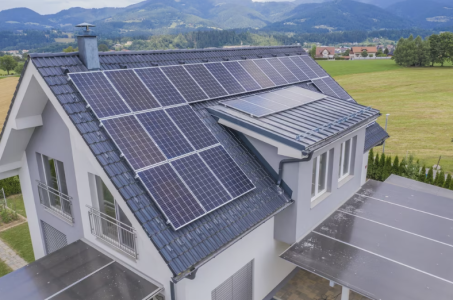Woman uses this strategy to slash her power bills to less than $80 per month
By
VanessaC
- Replies 14
In the face of soaring energy prices, many Australians are feeling the pinch.
But for Yvonne Parker, a retired social scientist living on Victoria's picturesque coastline, her monthly power bill is a mere $80.
She achieved this by investing in energy-efficient technology and taking advantage of government subsidies.
Yvonne has created a home that is not only comfortable year-round but also immune to the rising cost of power.
Her journey to energy efficiency was inspired by her childhood memories of sweltering summers in an uninsulated brick and concrete housing commission home.
'We find it so utterly liveable that we just love it,' she said, reflecting on her current home.
Yvonne and her daughter spent approximately $10,400 of their own money and utilised $6,500 worth of state government subsidies to install solar panels, a battery, an inverter, and a heat pump.
They predict that this investment will pay for itself in about six years.
As energy prices continue to climb, more Australians are following in Yvonne's footsteps.
Over 3.4 million households and businesses now have rooftop solar, and about 185,000 of these are backed by batteries.
Meanwhile, the median annual household bill across the National Energy Market is still a staggering $1,926—a 45 per cent increase in just two years.
The government's promise to cut household power bills by an average of $275 a year by 2025 seems increasingly unlikely as prices continue to rise, with increases amounting to about $600 being reported since the pledge was made.
Wholesale power prices seem to be the main culprit for this problem—which make up about 30 per cent of a power bill—as they hit record highs in 2022 following the Ukraine war and a series of outages at Australia's coal-fired power stations.
Despite these challenges, the government remains committed to transitioning to renewable energy, with a goal of 82 per cent of Australia's electricity coming from wind, solar, and hydro by 2030.
However, this transition comes with a hefty price tag.
The Australian Energy Market Operator estimates the total cost of phasing out coal and gas-fired power stations and replacing them with renewable energy sources to be about $383 billion by 2050.
While the transition to renewable energy is expected to ultimately result in cleaner and cheaper power, the initial capital costs of building these projects and renovating the grid to accommodate them will likely result in higher power prices for some time to come.
 What are your thoughts on the transition to renewable energy and its impact on power prices? Share them with us in the comments below.
What are your thoughts on the transition to renewable energy and its impact on power prices? Share them with us in the comments below.
But for Yvonne Parker, a retired social scientist living on Victoria's picturesque coastline, her monthly power bill is a mere $80.
She achieved this by investing in energy-efficient technology and taking advantage of government subsidies.
Yvonne has created a home that is not only comfortable year-round but also immune to the rising cost of power.
Her journey to energy efficiency was inspired by her childhood memories of sweltering summers in an uninsulated brick and concrete housing commission home.
'We find it so utterly liveable that we just love it,' she said, reflecting on her current home.
Yvonne and her daughter spent approximately $10,400 of their own money and utilised $6,500 worth of state government subsidies to install solar panels, a battery, an inverter, and a heat pump.
They predict that this investment will pay for itself in about six years.
As energy prices continue to climb, more Australians are following in Yvonne's footsteps.
Over 3.4 million households and businesses now have rooftop solar, and about 185,000 of these are backed by batteries.
Meanwhile, the median annual household bill across the National Energy Market is still a staggering $1,926—a 45 per cent increase in just two years.
The government's promise to cut household power bills by an average of $275 a year by 2025 seems increasingly unlikely as prices continue to rise, with increases amounting to about $600 being reported since the pledge was made.
Wholesale power prices seem to be the main culprit for this problem—which make up about 30 per cent of a power bill—as they hit record highs in 2022 following the Ukraine war and a series of outages at Australia's coal-fired power stations.
Despite these challenges, the government remains committed to transitioning to renewable energy, with a goal of 82 per cent of Australia's electricity coming from wind, solar, and hydro by 2030.
However, this transition comes with a hefty price tag.
The Australian Energy Market Operator estimates the total cost of phasing out coal and gas-fired power stations and replacing them with renewable energy sources to be about $383 billion by 2050.
While the transition to renewable energy is expected to ultimately result in cleaner and cheaper power, the initial capital costs of building these projects and renovating the grid to accommodate them will likely result in higher power prices for some time to come.
Key Takeaways
- Power bills have risen by 45 per cent in two years, with the median annual household bill now sitting around $1,926 across the National Energy Market.
- The transition to renewable energy, such as solar, can help Australians control rising power costs, as demonstrated by Yvonne Parker, who spends less than $80 a month on her power bills.
- The Australian Energy Market Operator predicts the total costs between now and 2050 to phase out coal and gas-fired power stations and switch to renewable energy will be about $383 billion.
- Renewable energy is expected to eventually lower energy costs. However, the capital costs involved in this transition need to be paid for hence energy prices are anticipated to remain high in the short term.








